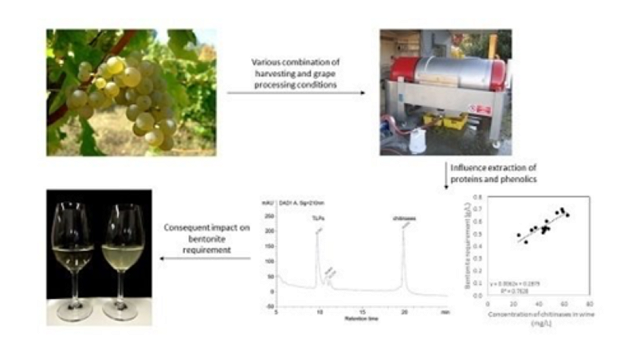Pathogensis-related proteins: What are these proteins and why are they clouding up my wine!
Joy Ting
October 2019
Proteins are an important component of all living cells, including grapes and yeast, and are therefore plentiful in grape must and wine. Most of these proteins are not unstable. In fact, the protein instability in a wine is not strongly correlated to the overall amount of protein in the wine (1,2). Many of the proteins found in grapes are removed in the process of fermentation. Yeast enzymes break some of them down for food. Others become unstable when cells burst and they are exposed to the acidic environment of the juice. These precipitate and are removed as part of the lees. Others denature (unfold) as the alcohol levels build up, precipitate and are removed. By the end of fermentation the proteins that are left are those that are resistant to proteases, tolerant of wine pH and alcohol levels (1).
In recent years, the specific proteins responsible for protein instability have been identified, allowing for a better understanding of conditions leading to protein instability as well as development of targeted techniques for treatment. Most of the unstable proteins come from the grapes, not the yeast and belong to a specific family of proteins called the pathogenesis-related (PR) proteins (2,1). These proteins are expressed in grapes from veraison to harvest, with increasing expression as ripening progresses (increasing with increasing brix). Higher levels of expression are also seen with stress, wounding, or microbial attack such as Botrytis and powdery mildew (2).

Figure 1: Pathogenesis-related proteins from grapes are responsible for protein instability in wine. From Tian et al 20175”
In grapes, PR proteins protect grapes from microbial attack by damaging the cell walls of invaders. Depending on the circumstances, these proteins can make up 50-70% of the soluble protein content of grapes at maturity reaching levels of 50-800 mg/L depending on cultivar, season and level of environmental stress. They are localized to the skins of the grapes (2,1).
Chemically, as expected, they are resistant to proteases (so not broken down by yeast during fermentation), soluble at low pH (so not precipitated out during fermentation), and they have minimal tannin binding (not removed during fermentation). As a result, these proteins are the major protein left after fermentation. Unfortunately, this means they are also very difficult to remove.
The family of pathogenesis-related proteins includes thaumin-like proteins, chitinases and B-glucanase. The chitinases have been identified as responsible for the majority of protein instability in wine. Based on melting point studies of each of these proteins, chitinases were most likely to denature and form irreversible, strongly associated haze while the other proteins in this group showed less probability to denature, and greater probability to re-fold without haze formation. Using linear regression of melting behavior, it was estimated that chinases would denature in 6 minutes at 55C, 3 days at 35°C or 2 years at 25°C. This timeframe is consistent with protein instability seen in aging wine3. Also, unlike overall protein concentration, a correlation was found between chitinase concentration and haze formation (4).
Practically why this matters:
The identity of chitinase as the main protein in protein haze formation explains why total protein content is not a good predictor of instability and why our current test for instability likely overestimates the amount of bentonite fining needed to stabilize the wine. It also allows for better development of treatments for protein haze, as well as better testing for instability. These are currently under development.
References
(1) Waters, E. J.; Muhlack, R. A.; Pocock, K. F.; Colby, C.; O’Neill, B. K.; Jones, P. Preventing Protein Haze in Bottled White Wine. Australian Journal of Grape and Wine Research 2005, No. 11, 215–225.
(2) Jackson, R. S. Wine Science: Principles and Applications, 4 edition.; Academic Press: Amsterdam, 2014.
(3) Robinson, E.; Scrimgeour, N.; Marangon, M.; Muhlack, R.; Smith, P.; Godden, P.; Johnson, D. Beyond Bentonite. Wine and Viticulture Journal 2012, No. November/December, 24–30.
(4) Ndlovu, T.; Divol, B.; Bauer, F. F. Yeast Cell Wall Chitin Reduces Wine Haze Formation. Appl. Environ. Microbiol. 2018, 84 (13)
(5) Tian, B.; Harrison, R.; Morton, J.; Jaspers, M.; Hodge, S.; Grose, C.; Trought, M. Extraction of Pathogenesis-Related Proteins and Phenolics in Sauvignon Blanc as Affected by Grape Harvesting and Processing Conditions. Molecules 2017, 22 (7)
